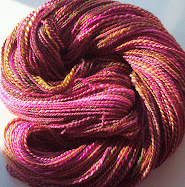
I'm participating in the Tour de Fleece over on Ravelry. Here's the fiber I'm starting with. It's British fine Shetland in a colorway called Agatha.
As with all things, there are lots of rules for tdf. But mostly you have to spin every day of the race. When the riders get a day of rest, the spinners get a day of rest. On the torturous mountain riding day, the spinners should spin a challenge, such as a fiber or structure they haven't spun before.
And we are encouraged to wear yellow whenever we are feeling like winners.









